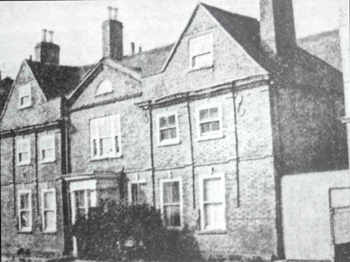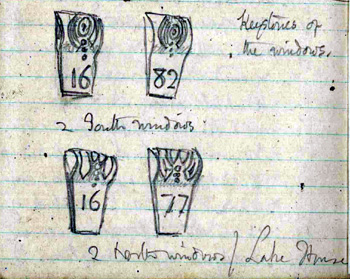The Maidenhead Lake Street Leighton Buzzard

Lake House about 1955
The Maidenhead Inn: 24 Lake Street, Leighton Buzzard
Leighton Buzzard has had two inns called the Maidenhead, in Lake Street and in Bridge Street. The Bedfordshire Magazine Volume V, page 106 noted that the dates 1677 and 1682 appeared on the keystones above the windows of the Lake Street Maidenhead, presumably the dates of its building. The stones are now in Luton Museum.
Maureen Brown, June Masters and Tom Lawson wrote a book called The Old Pubs of Leighton Buzzard and Linslade which was published by Leighton Linslade Local History Research Group in 1994. In producing the book they used sources at Bedfordshire & Luton Archives & Records Service, Buckinghamshire Record Office, Northamptonshire Record Office as well as a number of published sources. The authors state that Thomas Kayser or Keyser, a local man who emigrated to Jamaica, left the Maidenhead to his daughters Rebecca and Elizabeth, themselves married to Jamaican sugar planters and that the inn passed out of the family in 1689 when Edward Smith and John Spires of Jamaica surrendered all the property their wives had inherited to Emanuel Peacock.
In notes kindly lent to Bedfordshire and Luton Archives and Records Service, Maureen Brown is able to chart the ownership of the Maidenhead from the mid 17th century onwards. In 1692 Ann, wife of John Gladman, draper, was admitted to the copyhold Maidenhead, occupied by John Hood, Thomas Earle and Emmanuel Peacock.
Buckinghamshire Museum has an admission of a maltster, later his wife, to a pightle in Leck End next to the Maidenhead in 1693 and 1704, respectively. It also has a bond referring to the Maidenhead "together with orchard thereto belonging and adjoining and also all the additional buildings thereupon lately erected and built" in 1719. In 1713, Maureen Brown discovered that the Maidenhead was devised in his will by Thomas Thusrton, cook, to his daughter Mary and her husband Arthur Tarsey, who mortgaged the property about five years later. In 1719 Tarsey sold the mortgaged Maidenhead to William Stonhill of Leighton Buzzard, grocer, who surrendered it "and additional structures lately erected thereon" to Arthur Mathews of London and Letitia, his wife. Mathews was buying up a number of properties in the town around this time, including the Unicorn and Boot Inns [X288/3].
In 1727 Matthews, of Tavistock Street, Saint Paul's, Covent Garden [Middlesex] insured the Maidenhead with the Sun Insurance Office. In her notes, Maureen Brown gives details of the insurance, held by the Guildhall Library [11936/25] as follows:
- The Maidenhead Inn in the occupation of Alexander Adams the dwelling house and brewhouse all Brick Work and tiled £200;
- A range of stabling and out houses on the left side of the yard Thatched £45;
- A large Barn adjoining thatched £35;
- The stabling on the right side of the yard only £20.
Mathews died in 1746 and devised his property, including the Maidenhead, to Leighton Buzzard Justice of the Peace John Salusbury, who immediately surrendered it to the use of his own will [X288/5]. Salusbury seems to have lived at the Maidenhead [see below] which also seems, by that date, to have ceased to be an inn. It later came to be called Lake House. John Salusbury died in 1787. The following year Captain Arthur Clarke of Falmouth [Cornwall], to whom he had devised most of his real estate, was admitted and duly surrendered it to the use of his will [X288/9]. In 1806 Clarke surrendered a messuage "heretofore called the Maidenhead, with orchard, garden … late in occupation of John Salusbury, now Arthur Clarke, heretofore purchased of William Stonhill the elder" to William Claridge of Leighton Buzzard, carrier along with twenty five acres of arable land belonging to the Unicorn Farm [NC298].
In 1866 Edward and Percy Procter, executors of Joseph Procter, sold "a messuage in Leck End, Leighton Buzzard, formerly called Maidenhead with garden and yard formerly in occupation of John Salusbury, then Arthur Clarke, then William Claridge, then Arthur Ashfield, then Joseph Procter, now Percy Procter" to James Procter of London, woollen draper [Z1118/1/21/38] along with other land of Joseph Procter. It was appropriate that Procter lived in a former inn as he owned a brewery in the town, which he leased out, it stood on the site of the modern Waterborne Walk and stretched from the High Street to West Street, known in those days as Friday Street.
Under the terms of the Rating and Valuation Act 1925 every piece of land and building in the country was assessed to determine the rates to be paid on them. Leighton Buzzard was assessed in 1927 and the valuer visiting 24 Lake Street [DV1/R80/2-3] found it owned and occupied by Harold Proctor. The house comprised an entrance hall, dining room, morning room, inner hall, drawing room, kitchen, larder, scullery and W.C. on the ground floor. Beneath lay a basement containing four cellars. Above lay three principal bedrooms, three further bedrooms, a W.C. and a bathroom with W.C. The second storey comprised three attic bedrooms ["poor"] and two servants' bedrooms ["fair"]. Outside stood a brick and tile double coachhouse with two loose boxes and a loft over ["used for stores"], two small greenhouses, a "large flower and kitchen garden" and "the tennis courts are now disused, now used as a rabbit run". The valuer commented that the house had gas, but not electricity, laid on and was: "old fashioned brick and tile residence, large rooms, poor position from a residential point of view - right on road".

Frederick Gurney's sketches of Maidenhead date stones
On 14th August 1945 diarist and antiquarian Frederick G. Gurney of Eggington noted: "Having as usual some time to wait for a bus, I first went into the churchyard to verify the age given on the grave stone of Elizabeth Worrell, and then down lake Street etc. Seeing that Lake House is now abandoned by the military and that the broad sideway into the garden is no longer guarded by any kind of fence, I went in. It is in wild disorder, weeds and bushes rampant all over the place, no flower-beds visible any longer and the end of the garden near the west wall still occupied with the semi-circular huts of corrugated iron which I suppose must have housed some of the soldiers. They are all clean and habitable still, but quite empty. Between this part of the garden and the first section there is gateway with the head made from large ancient Gothic window of two lights (fifteenth century) no doubt from the church and in the corner a small summer-house with its front and two pillars of stately stone, whence I cannot guess. After the huts a tall wall, with a fastened but dilapidated door in each corner, far apart and beyond this is an orchard and kitchen garden and then apparently another cross-wall and an orchard. The place has been and could still be made into a beautiful garden. I did not try to examine the house; obviously it was locked up. The kitchen premises, however, are modern additions to the back of it on the south side and of no beauty or interest whatever. I roughly sketched on the next page the four key stones of the windows and the front which bear the two dates" [see above].
The house was, sadly, demolished in 1956. Ironically this was just as other properties in the town were being listed for architectural and historic interest by the Department of Environment. The site is now Duncombe Drive leading to the fire station and telephone exchange. It is hoped that at some point in the near future a small archaeological excavation can be carried out on part of the site.

The gap denotes the site of 24 Lake Street - June 2008
References:
- X288/3: surrender: 1719;
- X288/5: death of Arthur Matthews: 1746;
- X288/5: admission: 1746;
- X288/9: admission: 1788;
- NC298: admission: 1806;
- Z1118/1/21/38: bargain and sale: 1866;
- P91/28/48: noted as 24 Lake Street in notes compiled on Leighton Buzzard public houses: early 20th century;
- X325/94: Frederick G. Gurney's notes: 1945
List of Licensees: note that this is not a complete list; entries in italics refer to licensees where either beginning or end, or both, dates are not known:
1689: Mary Keene, widow;
1719-1727: Alexander Adams